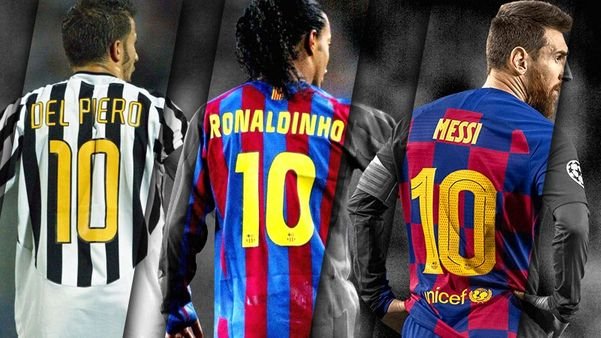- Last Updated -
The Transformation of Midfielders Roles in Soccer
The Evolution of Soccer Tactics

Soccer, once a game characterized by simplicity and brute force, has evolved into a tactical labyrinth. Gone are the days when teams relied solely on physicality and raw skill to triumph on the pitch.
The beautiful game has experienced a profound shift, as managers and coaches now meticulously devise strategies to gain an upper hand over their opponents.
The evolution of soccer tactics has given rise to a new era of innovation and sophistication. Gone are the times when teams would deploy traditional formations like 4-4-2 or 4-3-3 without much thought behind them.
Nowadays, every aspect of the game is analyzed down to its minutest detail: from player positioning to passing patterns, from defensive shape to attacking movements. Coaches have become veritable chess masters, moving their pieces across the pitch with calculated precision.
This transformation in tactics can be attributed to several factors. Firstly, technological advancements have allowed for more accurate data analysis and enhanced scouting networks.
Teams now have access to detailed statistics on player performance, which enables them to identify strengths and weaknesses not only within their squad but also within their adversaries’ ranks. Furthermore, globalization has played a significant role in disseminating ideas across borders.
Coaches can now draw inspiration from successful systems implemented by clubs around the world. Concepts that were once considered unorthodox or foreign are now embraced with open arms as managers seek any advantage they can find.
The Importance of Midfield Roles in Modern Soccer
While all positions on the soccer field play crucial roles, it is undeniable that midfielders hold a special place in modern soccer. They act as the engine room, the orchestrators who dictate the tempo and rhythm of play.
The midfield battle often determines which team gains control over possession and ultimately influences the outcome of matches. In the past, midfielders were primarily tasked with distributing the ball and maintaining positional discipline.
However, as the game has evolved, so too have their roles. Midfielders are now expected to contribute both defensively and offensively.
They must possess a wide range of skills: vision, passing accuracy, dribbling ability, defensive awareness, and tactical intelligence. In the modern game, midfielders are not mere cogs in a well-oiled machine; they are the architects of success.
They create scoring opportunities with their incisive passes, break up opposition attacks with their well-timed tackles, and provide essential support to both defense and attack. With competent midfielders who can seamlessly transition between different phases of play, teams would be able to maintain possession or launch effective counter-attacks.
Soccer tactics have undergone a metamorphosis over time. Coaches have become tacticians par excellence while players adapt to increasingly specialized roles on the field.
Midfielders have emerged as pivotal figures in this changing landscape – their ability to control games through skillful distribution and tenacious defense is crucial for any team aspiring to dominate at the highest level.
So next time you watch a soccer match marvel at the artistry displayed by these midfield maestros as they work tirelessly in search of glory on behalf of their teams.

The Defensive Midfielder: Shielding the Defense and Initiating Attacks
Preserving the Fort: A Historical Precursor to the Defensive Midfielder
In the annals of soccer history, one cannot undermine the significance of the sweeper role as a precursor to the modern defensive midfielder. The sweeper, stationed just behind the backline, acted as a safeguard against marauding attackers, sweeping away any potential threats with precision and timing.
This early manifestation highlighted the importance of having a player dedicated to shielding the defense. It laid down the foundations for what would eventually become an essential position in contemporary soccer.
Modern Defensive Midfielders: The Unsung Heroes with Key Attributes
Today’s game demands more than just raw strength and defensive prowess from midfielders. Modern defensive midfielders are an embodiment of tactical intelligence, poise under pressure, and exceptional ball distribution skills.
These players possess a remarkable ability to read opposition movements, intercept passes and initiate counter-attacks swiftly. They are often responsible for dictating play from deep positions, connecting defense with attack seamlessly.
Key attributes that set modern defensive midfielders apart include their exceptional positional awareness, analytical thinking on and off the ball, vision to exploit gaps in rival defenses, and tenacity in winning back possession.
Their discipline is exemplary; they tirelessly patrol between lines while orchestrating their teammates’ positioning like conductors leading an orchestra.

The Central Midfielder: Orchestrating Play and Linking Defense with Attack
Maestros Amidst Chaos: Box-to-Box Midfielders Combine Defensive and Offensive Duties
Box-to-box midfielders epitomize versatility in their purest form. These dynamic athletes contribute significantly at both ends of the pitch – defensively shutting down opponents’ advances while simultaneously instigating attacks from deep within their half.
They serve as engines that never cease to run, relentlessly covering every blade of grass, and tirelessly pressing the opposition. A box-to-box midfielder’s role encompasses defensive duties such as breaking up play, intercepting passes, and providing defensive cover for their teammates.
Simultaneously, they possess the stamina and drive to surge forward during attacking transitions, offering support to strikers or even finding themselves on the end of goal-scoring opportunities. Their tireless work rate allows them to seamlessly traverse between midfield and attack with boundless energy.
Creative Architects: Playmakers as Creative Maestros
Playmakers are the esteemed architects of a team’s attacking moves – creators par excellence who orchestrate play from central positions. These midfield magicians possess a unique blend of vision, technical ability, and exceptional passing range that sets them apart from their peers.
Gifted with an innate ability to thread precise through balls or execute pin-point crosses, these playmakers unlock defenses with their sublime touches and audacious flair.
Their artistry lies in their ability to manipulate space and time on the pitch – simultaneously analyzing opponents’ movements while seeking gaps in their lines like master chess players plotting intricate moves.
The playmaker’s role is not only about creating goal-scoring opportunities but also about manipulating the rhythm of the game by maintaining possession intelligently or launching incisive counter-attacks when required.
Through these traditional midfield roles – be it shielding defenders or orchestrating attacks – soccer has witnessed a mesmerizing showcase of talent across generations.
The evolution and adaptation of these roles have transformed mere positions into essential cogs in modern tactical systems. As we delve deeper into the transformational journey of midfield roles in soccer, we uncover even more specialized positions that have emerged in response to changing strategies on the pitch.

The Rise of Specialized Midfield Roles
The holding midfielder: An anchor in possession-based systems
The Unsung Hero of Modern Midfields Ah, the holding midfielder, the unsung hero who anchors the midfield and keeps possession ticking.
In this era of possession-based systems, their importance cannot be overstated. Gone are the days when midfielders were expected to contribute equally in defensive and attacking duties.
The holding midfielder is now tasked with shielding the defense and distributing the ball with precision. Enter the regista, a deep-lying playmaker who dictates tempo from deep positions.
This role was popularized by legendary football stars like Andrea Pirlo and Xabi Alonso. These maestros of distribution orchestrate play from behind, spraying incisive passes to break through stubborn defensive lines.
Their vision and ability to control the game’s rhythm make them invaluable assets on the pitch. But let’s not forget about their counterpart, the anchor man.
While registas thrive on creativity, anchor men focus on breaking up opposition attacks with their unwavering determination and tactical awareness. They are relentless in their pursuit of intercepting passes and making crucial tackles whenever danger lurks around their territory.
The attacking midfielder: Unlocking defenses with flair and vision
The Ingenious Architects of Beautiful Football Oh, how I adore those creative masterminds known as attacking midfielders! They possess an innate ability to unlock defenses with flair, vision, and audacious skill.
They are like conductors guiding an orchestra – every deft touch or calculated pass brings harmony to their team’s offensive endeavors. The classic number 10s are perhaps the most celebrated type of attacking midfielders in history.
These traditional creators revel in threading inch-perfect through balls behind enemy lines or unleashing thunderous shots from outside the box that leave goalkeepers frozen in awe. Think of legends such as Zinedine Zidane, Diego Maradona, and Michel Platini; their creativity and ability to control the game from advanced positions were simply unparalleled.
In recent years, however, a new breed of attackers has emerged: the false nines and trequartistas. These enigmatic beings blur the lines between midfield and attack, wreaking havoc upon defenders who can’t quite figure out where they belong.
False nines are deceptive, dropping deep to confuse markers and create space for teammates. Trequartistas, on the other hand, operate in between the lines with their mesmerizing footwork and delicate touches that leave defenders hypnotized.
The rise of specialized midfield roles has brought a wealth of excitement to the beautiful game. The holding midfielder’s role as an anchor in possession-based systems adds stability and control to teams’ playstyles.
Meanwhile, the attacking midfielder brings a touch of artistry to the pitch by unlocking defenses with their flair and vision. Whether it’s the regista dictating play from deep positions or the false nine bamboozling opponents with their movement, these specialized midfielders have elevated soccer tactics to new heights.
So next time you watch a match, take a moment to appreciate these midfield maestros who navigate the course of games with their tactical prowess and technical brilliance. Without them, soccer would be incomplete; devoid of its artistic essence that keeps us all captivated.

The Modern Midfield Revolution
The Inverted Winger as a Pseudo-Midfielder: Redefining the Flank
In recent years, a fascinating trend has emerged in modern soccer tactics—the rise of the inverted winger as a pseudo-midfielder. Traditionally, wingers were known for their lightning-fast pace and ability to hug the touchline, stretching defenses and providing crucial crosses into the box.
However, with the evolution of tactical intricacies, coaches across the globe have begun experimenting with a new breed of winger—one who operates centrally rather than sticking to the flanks.
The Rise of Inverted Wingers in Modern Tactics: Breaking Down Defenses Differently
The emergence of inverted wingers has revolutionized how teams attack. By cutting inside from wide positions and drifting into central areas, these players create an overload in midfield that can confound opposition defenses.
This tactical innovation not only gives teams increased numerical superiority in crucial areas but also enhances creativity and unpredictability in attacking play. Top clubs like Barcelona and Manchester City have mastered this approach, with players like Lionel Messi and Kevin De Bruyne wreaking havoc from inverted positions.
These skillful individuals combine their natural dribbling ability with intelligent off-the-ball movement to exploit gaps between defenders or provide incisive through-balls for strikers making diagonal runs. The result is an intricate dance on the pitch that mesmerizes spectators and leaves defenders bewildered.
Advantages and Challenges Associated with This Role: A Tactical Balancing Act
While the inverted winger role offers numerous advantages for teams seeking to dominate possession and create intricate passing patterns, it comes with its fair share of challenges. Firstly, this position demands high levels of technical ability coupled with exceptional spatial awareness.
Players must be comfortable receiving the ball in tight spaces surrounded by opponents while still maintaining control and making quick decisions. Additionally, the inverted winger role requires a delicate balance between offensive and defensive responsibilities.
These players must contribute defensively by pressing opponents and providing cover for overlapping fullbacks, all while ensuring they aren’t caught out of position when the team loses possession. It is a constant juggling act that demands immense discipline, tactical intelligence, and versatility from those who wish to excel in this unorthodox role.
The Emergence of Hybrid Roles: A Fusion of Midfield Artistry
As modern soccer continues its evolution, we are witnessing the emergence of hybrid midfield roles that blur the lines between traditional positions.
One such example is the box-to-box playmaker—a versatile force capable of seamlessly transitioning between defensive solidity and incisive attacking contributions. These players possess an exceptional work rate, combining tireless energy with technical prowess to impact every aspect of the game.
Another intriguing hybrid role is the trequartista-meets-holding-midfielder hybrid. This extraordinary blend combines the vision and creativity of an attacking midfielder with the defensive awareness and positional discipline of a holding midfielder.
This type of player serves as a metronome in midfield, orchestrating attacks while providing stability at the heart of the team. Midfield roles in soccer have undergone a remarkable transformation in recent years.
The rise of inverted wingers has breathed new life into attacking strategies, adding flair and unpredictability to teams’ arsenals. Moreover, as hybrid roles continue to emerge on pitches worldwide, we can only marvel at how these innovative concepts redefine what it means to be a midfielder in today’s beautiful game.

Rarely Known Details on Midfield Roles
Lesser-known Defensive Midfielders: Unsung Heroes of the Pitch
Defensive midfielders, often overshadowed by flashy attackers and goal-scoring heroes, deserve more recognition for their vital contributions to a team’s success.
While their primary role is to shield the defense and break up opposition attacks, lesser-known defensive midfielders possess a unique set of skills that make them invaluable assets.
Take, for instance, the unsung hero who seamlessly transitions from screening the backline to initiating quick counter-attacks with accurate long-range passes. These gritty warriors are masters of anticipation and positioning, constantly thwarting opponents’ advances while providing stability in midfield.
Creative Destroyers: The Adventurous Holding Midfielder
When thinking about holding midfielders, one commonly imagines players focused solely on breaking up play and distributing possession safely. However, there exists a breed of holding midfielder that defies this stereotype: the creative destroyer.
This hybrid role merges defensive solidity with an adventurous spirit that drives them forward to make incisive passes or release long-range shots. These rare gems possess exceptional vision and timing, allowing them to disrupt opponents’ rhythm all while orchestrating attacking moves.
Hidden Gems: Elite Attacking Midfielders with Unconventional Styles
While classic number 10s steal the limelight with their dazzling dribbles and pinpoint passes behind strikers, there exists another realm of attacking midfield brilliance that often goes unnoticed – those with unconventional styles.
Picture a trequartista gracefully gliding across the pitch, baffling defenders with unpredictable movements and mesmerizing close control skills.
Or envision a false nine dropping deep into pockets of space to link up play intelligently while also exploiting gaps in defensive lines through well-timed runs. These lesser-known attacking midfield maestros bring a touch of unpredictability that can unlock even the most stubborn defenses.
Conclusion
In the dynamic world of soccer, midfield roles have undergone a remarkable transformation, paving the way for diverse and specialized positions.
From unsung heroes fulfilling defensive duties to holding midfielders with creative flair, and from classic playmakers to unorthodox attacking midfielders, these players bring unique contributions to their teams. These rarely known details showcase the depth and intricacy of midfield roles in modern soccer. (1)
Concussion Substitutions in Soccer: evolving concussion protocols
The Growing Concern for Player Safety in Soccer Soccer, a beloved sport...
Read MoreSoccer Substitution Rules: The Strategic Art of Changing the Game
Soccer, known as the beautiful game worldwide, has seen various changes to...
Read MoreBox-to-Box Center Midfielder: The Engine of Modern Soccer Teams
Soccer is a game of skill, strategy, and teamwork. Every player has...
Read MoreThe Historical Dominance of Brazilian Soccer in the World Cup
Introduction: The Beautiful Game's Grandest Stage The World Cup, a grand tournament...
Read More
















